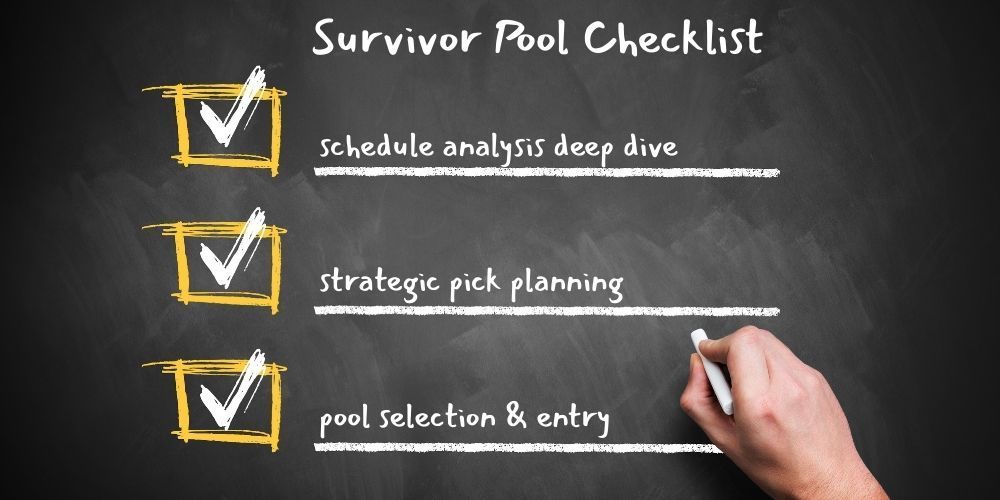How Pool Size Affects Your Survivor Strategy: From Small Leagues to Massive Pools
William Flaiz • May 13, 2025
When it comes to NFL survivor pools, size doesn't just matter—it fundamentally changes your optimal strategy. Whether you're in a small office pool with 20 colleagues or a national contest with thousands of participants, the number of competitors should directly influence your weekly picks and long-term planning. Let's analyze exactly how pool size impacts your decision-making and how to adjust your strategy accordingly.

The Mathematics of Pool Size
At its core, survivor pool strategy involves balancing two competing objectives:
- Survival probability: Maximizing your chances of surviving each week
- Winning probability: Maximizing your chances of being the last player standing
In small pools, these objectives often align. In large pools, they frequently diverge—creating strategic tension that smart players can exploit.
Small Pool Dynamics (Under 50 Participants)
In small pools, the math is relatively straightforward. With fewer competitors, your primary focus should be survival probability:
- Win probability = (Your survival probability) × (1 ÷ Expected remaining players)
- Example: In a 20-person pool in Week 6, if 12 players remain and you have a 90% chance of surviving, your win probability is approximately 90% × (1 ÷ 12) = 7.5%
This formula reveals why the conservative approach typically works best in small pools. By consistently making high-probability picks, you maximize your chances of outlasting a limited field.
Large Pool Dynamics (100+ Participants)
As pool size increases, the equation changes dramatically. Consider this formula for large pool win probability:
- Win probability = (Your survival probability) × (1 ÷ Expected remaining players)
- Example: In a 1,000-person pool in Week 6, if 400 people remain and you have a 90% chance of surviving, your win probability is approximately 90% × (1 ÷ 400) = 0.225%
Notice how your win probability plummets in larger pools despite making the same conservative 90% pick. This mathematical reality drives the need for contrarian strategies in larger contests.
Strategic Adjustments Based on Pool Size
Micro Pools (Under 25 Players)
In the smallest pools, survival is paramount. Your strategy should be:
- Pick the safest team each week, even if it's highly popular
- Preserve premium teams for future weeks when possible
- Avoid unnecessary risks early in the season
- Ignore pick popularity since game theory matters less with few players
With few competitors, the chances of everyone else making the same pick are low, making contrarian strategy less necessary.
Small-Medium Pools (25-100 Players)
As pool size increases into double digits, begin incorporating some strategic thinking:
- Primarily focus on survival probability
- Start considering popularity when choosing between similarly safe options
- Track competitors' remaining teams in later weeks
- Consider contrarian picks only in later weeks when the field has narrowed
Example: If the Chiefs (-14) and Bills (-13) are both available to you in Week 4, and you project the Chiefs to be picked by 45% of your pool versus 25% for the Bills, the slight safety difference might be outweighed by the popularity gap.
Large Pools (100-500 Players)
With triple-digit participants, game theory becomes increasingly important:
- Balance safety and popularity from Week 1
- Actively look for "value picks" (teams with high survival probability but low expected popularity)
- Save popular powerhouse teams for strategic deployment
- Consider slightly riskier picks against popular consensus (when the risk/reward makes sense)
Massive Pools (500+ Players)
In the largest contests, contrarian strategy becomes essential:
- Pick popularity becomes nearly as important as survival probability
- Actively avoid the most popular team each week unless they offer overwhelming value
- Make at least 2-3 contrarian picks throughout the season
- Plan multiple weeks ahead to navigate around popularity trends
- Deploy major favorites strategically when others may have used them
Mathematical Example: Expected Value Calculation
Let's illustrate this with an example from a hypothetical Week 5:
Team A: 85% win probability, expected to be picked by 40% of pool
Team B: 75% win probability, expected to be picked by 10% of pool
- In a 50-person pool with 30 players remaining:
- Team A: 85% × (1 ÷ (30 × 60%)) = 4.7% win probability
- Team B: 75% × (1 ÷ (30 × 90%)) = 2.8% win probability → Team A is the better pick
- In a 1,000-person pool with 600 players remaining:
- Team A: 85% × (1 ÷ (600 × 60%)) = 0.24% win probability
- Team B: 75% × (1 ÷ (600 × 90%)) = 0.14% win probability → Team A is still better, but the gap narrows
- In a 10,000-person pool with 6,000 players remaining:
- Team A: 85% × (1 ÷ (6,000 × 60%)) = 0.024% win probability
- Team B: 75% × (1 ÷ (6,000 × 90%)) = 0.014% win probability → The difference becomes negligible, making Team B potentially more attractive if it helps preserve stronger teams for future weeks

Common Mistakes Based on Pool Size
Small Pool Mistakes
- Over-complicating strategy: Making contrarian picks in a 15-person office pool is often unnecessary risk
- Using premium teams too early: With fewer competitors, your Jets/Jaguars/Lions picks become more valuable late-season assets
- Ignoring competitors' remaining teams: In small pools, you can often track others' used teams to inform your strategy
Large Pool Mistakes
- Playing too conservatively: Picking the most popular team each week virtually guarantees you won't win in large pools
- Failing to map out a season-long plan: Large pools require more strategic planning across multiple weeks
- Taking excessive risks: Contrarian doesn't mean reckless—look for calculated opportunities to differentiate
- Ignoring advancing-odds pools: In pools that offer reduced entry fees for late entry, the field size will grow dramatically in later weeks
Advanced Strategy: Adapting Mid-Season
Pool size isn't static—it changes every week as players are eliminated. Your strategy should evolve accordingly:
- Early season (Weeks 1-4): Strategy dictated by initial pool size
- Mid-season (Weeks 5-10): Adjust based on remaining competitors
- Late season (Weeks 11+): Consider more aggressive moves as the field narrows
Example: A pool that starts with 500 participants might have only 75 remaining by Week 7. At this point, shift from large-pool strategy toward medium-pool tactics.
Case Study: 2024 Season Week 8
In Week 8 of the 2024 NFL season, we saw a perfect illustration of pool size strategy:
- The Chiefs were 13-point favorites hosting the Panthers
- In small pools (under 50), the optimal play was simply taking KC
- In medium pools (50-100), the Eagles (10-point favorites vs. Giants) offered slightly less safety but much less popularity
- In large pools (100+), the Texans (8-point favorites vs. Titans) presented compelling contrarian value
The results:
- Chiefs won comfortably, 34-10
- Eagles won by a touchdown, 27-20
- Texans upset by Titans, 23-21
This outcome eliminated approximately 22% of remaining contestants in large pools who had sought the contrarian Texans pick. Was this a strategic mistake? Not necessarily—the expected value calculation still supported the decision in pools over 1,000 participants. That's the reality of large-pool strategy: higher variance moves that sometimes backfire but maximize long-term expected value.
Multi-Entry Strategy in Large Pools
For players with multiple entries in large pools, size dictates an optimal diversification strategy:
- Small pools: Make similar conservative picks across entries
- Medium pools: Diversify only when facing equally viable options
- Large pools: Deliberately diversify to cover both conservative and contrarian angles
- Massive pools: Create distinct "portfolio" strategies for each entry
Final Thoughts: Matching Strategy to Pool Size
Your survivor pool strategy should always reflect the specific contest you're in. The perfect strategy for a 25-person office pool would be disastrous in a 10,000-person national contest, and vice versa.
Remember these key principles:
- Smaller pools reward consistency and safety
- Larger pools reward calculated contrarian plays
- All pools require adjusting strategy as the field narrows
- Balance weekly survival with long-term winning probability
By understanding the
mathematical relationship between pool size and optimal strategy, you'll gain a significant edge over competitors who apply a one-size-fits-all approach to survivor pool decision-making.
How does pool size affect the value of saving strong teams for later weeks?
The value of preserving premium teams increases with pool size. In small pools (under 50 participants), you can often win by simply making it to Week 14-15, making it reasonable to use top teams earlier if they provide overwhelming safety. In large pools (100+ participants), you'll likely need to survive deep into the season, possibly all 18 weeks. This makes team preservation far more important, as you'll need reliable options in the difficult late-season weeks when the schedule is less predictable and divisional matchups dominate. In massive pools (1,000+), you should generally avoid using more than one premium team (teams that will be double-digit favorites multiple times) in the first month unless they offer exceptional contrarian value.
Should my strategy change in elimination pools versus survivor pools?
Yes, elimination pools (where you pick losers instead of winners) require strategic adjustments regardless of pool size. First, public perception tends to focus more on good teams than bad ones, making popularity distribution more concentrated and predictable. Second, the mathematical edge often tilts toward home underdogs in elimination formats, as the public tends to overvalue road favorites. In small elimination pools, you can generally focus on picking the weakest teams. In large elimination pools, look for teams that are genuinely weak but not obviously terrible—these "sneaky bad" teams often provide the perfect combination of high loss probability and low popularity. For example, a 4-7 team facing a 9-2 opponent might actually offer better value than an 0-11 team that everyone will target.
How should I adjust my strategy in pools that require multiple picks each week?
Multiple-pick formats fundamentally change the mathematics of survival. In standard one-pick pools, a 90% survival probability for one week is just that—90%. In a two-pick pool, your weekly survival probability becomes the product of both individual pick probabilities (0.9 × 0.9 = 81%). This compounding effect makes the "safest option available" strategy even more important in small multi-pick pools. However, in large multi-pick pools, you face an interesting strategic opportunity. The multiple picks actually provide space to balance conservative and contrarian selections each week. For example, in a 1,000+ participant pool requiring two weekly picks, you might pair a very safe, popular team with a moderately safe but unpopular team, creating a balanced portfolio approach that optimizes your expected value while maintaining reasonable weekly survival odds.











